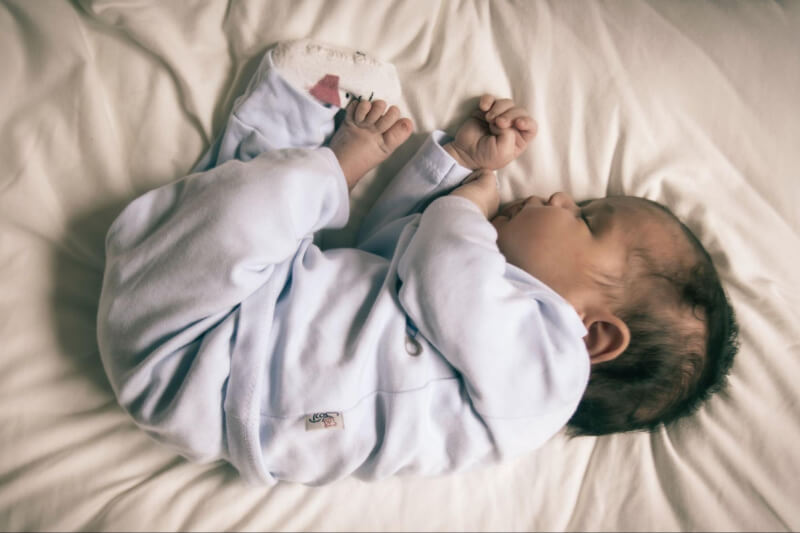
We try not to generalize about parenthood, but we can safely say this: No matter what, you never experience sleep the same after you have a baby.
Those middle-of-the-night feedings, the won’t-go-to-sleep-no-matter-whats, or the you’ll-be-up-til-midnights-because-of-a-late-naps?
What did sleep even actually feel like before you had children?
(And even when they do sleep, there’s the sneaking-in-to-check-they’re-still-breathing and the can’t-stop-staring-at-how-perfect-they-are moments, too.)
These experiences are normal parts of parenting and sleep, but when you’ve got a baby who is breastfeeding and co-sleeping?
That’s a whole different experience, and it’s one that brings up lots of questions for parents.
Co-sleeping: Does it refer to your baby sleeping in your bed? In the same room with you? What about sidecars or attachable bassinets?
Before we get started, let’s all get on the same page as far as language goes. Co-sleeping broadly includes any kind of sleeping in the same room as your baby, regardless of what the sleep surface is.
Room-sharing is one approach to co-sleeping. With room-sharing, your baby sleeps in the same room as you, but they have their own sleep surface—a bassinet, crib, pack-and-play, or another safe surface.
The American Academy of Pediatrics (AAP) recommends room-sharing for at least the first six months of your baby’s life. According to the AAP, room sharing reduces the risk of SIDS by as much as half.
On the other hand, bedsharing is exactly that: parents sharing a sleep surface with their baby.
It’s hard to say exactly how many families co-sleep because data relies on families to self-report, and many families aren’t comfortable with sharing their sleep situation with researchers.
Recent research indicates that co-sleeping is a growing practice in the United States. (Worldwide, that’s another story—co-sleeping is widely practiced in many other countries.)
In a 2011-2014 survey published in Academic Pediatrics, 65.5% of mothers reported usually room sharing (without bedsharing), while 20.7% reported bedsharing. And according to another study, since 1993, the practice of bedsharing in the U.S. has grown from about 6 percent of parents to 24 percent in 2015.
Parents are rightly concerned about making sleep as safe as possible no matter where their baby sleeps since, sadly, the CDC reports that approximately 3,700 babies die each year in the U.S. from sleep-related causes, including Sudden Infant Death Syndrome (SIDS), accidental suffocation, and accidental strangulation.
It can feel supportive to know how many families out there practice some sort of co-sleeping—a lot do! But what does that information mean—is it safe, or is it dangerous?
Co-sleeping, broadly speaking, is widely regarded as safe for your baby.
As noted, the AAP recommends room sharing for the first six months of your baby’s life.
But bedsharing is a different, and more nuanced, story. While some infant sleep specialists and pediatricians enthusiastically advocate for bedsharing, others just as enthusiastically recommend against it.
The AAP’s safe sleep policy warns against bedsharing based on several studies that link bedsharing to an increased risk for sleep-related death. However, critics of the AAP’s position point out that the studies it cites overlook factors like:
However, some infant sleep specialists strongly argue for the importance of co-sleeping, particularly bedsharing, with a baby. One of the best-known proponents of bedsharing is anthropologist and infant sleep specialist James McKenna.
McKenna’s research looks at both historical practices around the world and studied current sleep habits of families. He and his research partner, Lee Gettner, use the term “breastsleeping” to describe the breastfeeding/co-sleeping arrangement, referring to it as “humankind’s oldest and most successful sleep and eating arrangement.”
Other experts in the field point to flaws in the data that the AAP uses to recommend against bedsharing.
According to the Academy of Breastfeeding Medicine, “Existing evidence does not support the conclusion that bedsharing among breastfeeding infants (i.e., breastsleeping) causes sudden infant death syndrome (SIDS) in the absence of known hazards. Larger studies with appropriate controls are needed to understand the relationship between bedsharing and infant deaths in the absence of known hazards at different ages.”
“Since bedsharing is such an obvious way to meet babies’ needs for closeness and nighttime feeds, it makes sense to provide parents practical ways to remove potential hazards so everyone can relax and get some sleep,” notes Nicole Pogrund, Nest Collaborative IBCLC.
Parents want to keep their children safe, that’s a given. But everyone has a different picture in their head of what safe is—and that’s why it’s so important for healthcare providers, researchers, and parents to be on the same page when it comes to what “safe” means, particularly when it comes to sleep.
No matter what room your baby’s sleeping in, no matter whether they’re on the same surface as you or not, parents should always follow these guidelines for creating a “safe sleep” environment:
While the AAP recommends co-sleeping, but not bedsharing, it’s a reality that many families find that bedsharing works well for them. If you’re interested in bedsharing but concerned about safety, there are steps you can take to make bedsharing safer.
First, it’s important to note that breastfeeding is commonly cited as a factor in making bedsharing safer. First, breastfed babies—particularly those who are exclusively breastfed for two months or longer— have lower rates of SIDs than formula-fed babies.
Another reason is that when breastfeeding at night, the breastfeeding parent typically forms a C-shape around their baby as they nurse in a side-lying position. This position prevents the breastfeeding parent from overlying or rolling over onto their baby.
Other researchers suggest that physical closeness between a breastfeeding parent and a baby during the nighttime helps regulate a baby’s heart rate, breathing, and body temperature.
But breastfeeding alone isn’t sufficient to create a safer bedsharing environment. Other necessary steps to take to promote safer bedsharing include the following:
Do not sleep with your baby on a couch, recliner, or memory foam style mattress—having a firm flat surface without gaps is essential to reduce suffocation risks.
If you’re a parent—especially a new parent—you’re probably tired. We’re going to guess you’re not looking to make any changes that make you more tired than you already are.
One common concern about co-sleeping is that you’ll end up getting less sleep than if your baby is in their own room. Unfortunately, it’s hard to say—all babies have their own sleep personality.
Studies have found, though, that co-sleeping families—specifically, breastfeeding parents and their babies—sleep best together. Co-sleeping allows babies easy access to nursing throughout the night, and this delivers many, many benefits:
And, you guessed it, better perception of sleep in both quantity and quality.
“Bedsharing parents can often wake only briefly to help their babies latch and then sleep, or at least, rest deeply during the feed,” says Pogrund, “so it makes sense they feel more rested in the morning.
We love being able to give a big, enthusiastic “YES!” to something.
Whether you share the same sleep surface with your baby or not, co-sleeping is hugely beneficial to your breastfeeding journey. It positively impacts your milk supply and the duration of breastfeeding.
When it comes to milk supply, it’s really about breastfeeding mechanics: supply and demand, and hormones. Breastfeeding at night means more opportunity to remove milk from the breast, which in turn signals your body to make more milk.
What’s more, your body produces higher levels of prolactin, the hormone that supports milk production, at night. When taken in tandem, these factors lead to more milk being produced.
And, of course, there’s the obvious benefit to co-sleeping for breastfeeding parents: You don’t have to leave your room to feed the baby, making middle-of-the-night feedings much easier.
But what about breastfeeding duration? According to a U.K. study, breastfeeding families who also bedshared were more motivated to breastfeed past the six-month mark. Interestingly, the author of the study notes that bedsharing parents viewed breastfeeding as important before having their baby.
“Having your baby close to you at night makes nighttime feedings easier,” says Pogrund. “And it’s comforting on a deep instinctual level for babies and parents, too.
Our team of IBCLCs is passionate about helping families find their best path to a successful breastfeeding journey—and sometimes cosleeping is part of that. If you’ve got questions, we’d love to help. Book a convenient online video appointment with a Nest Collaborative IBCLC today.
